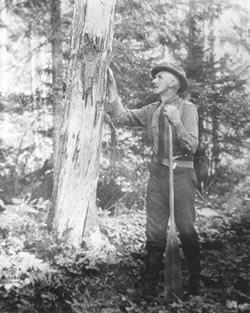When Tom Thomson was first reported missing on July 10, 1917, his friends around Algonquin Park's Canoe Lake expected that he had merely encountered a bit of trouble, and that he would reappear soon. Even Mark Robinson, the Algonquin Park Ranger who led the search for Thomson noted in his daily diary his belief that Tom had likely merely hurt himself and was awaiting assistance. Initial newspaper coverage - in Thomson's hometown of Owen Sound, as well in Toronto - suggested that Tom had experienced some kind of accident.
Thomson's body was found floating in Canoe Lake on July 16, 1917. Within 24 hours, it was examined by a doctor holidaying in the park, accompanied by Park Ranger Robinson. The doctor pronounced the cause of death as drowning. Among folks at Canoe Lake, the general sense was that Thomson's death was a terrible accident.
On July 18, 1917, two days after Thomson's remains were discovered, they were buried at a small cemetery on a hill overlooking Canoe Lake. The coroner arrived the evening following Thomson's burial, and conducted interviews with people around Canoe Lake, including the doctor who examined Thomson's body. The coroner likely agreed with the conclusion of 'accidental death', as he produced documents approving the burial of Thomson's remains, without alerting authorities to begin an investigation.
Despite the doctor's finding, and likely concurrence of the coroner, during the fall of 1917, the Thomson family was compelled to further consider whether Tom's death had really been accidental. Letters from the time indicate rumours that Tom had committed suicide were circulating at Canoe Lake. The Thomson family maintained the belief, however, that Tom had died by accident.
Public Expression of Doubt
The first public claim that Tom might not have died by accident was published in 1935. In large part, it was based on testimony about Thomson’s corpse that Park Ranger Mark Robinson had provided during 1930 and 1931. During the 1950s, another version of Robinson's accounting of events was recorded. In this version of his testimony, he expanded on details he introduced into the story during the 1930s.
During the early 1970s, the idea that Thomson died by accident was challenged by authors such as William Little and Roy MacGregor. These writers suggested it was far more likely Thomson died by murder or suicide. They suggested the idea that Thomson died by accident was part of a cover-up conspiracy. Their claims, despite tenuous foundations, have come to dominate discussion of the case.
Denials and Reconsiderations
In 1977, David Silcox would attempt to rehabilitate the accident explanation by picking up on comments made by Thomson relatives during the late 1960s. He offered that due to a sprained ankle, Thomson had likely fallen out of his canoe while urinating. Few have taken this proposal seriously, however.
Silcox’s idea notwithstanding, since the early 1970s, the prospect that Tom Thomson died by accident seems to have become the ‘outside contender’ in storytelling about the case. Taking up claims made by Robinson over the course of three decades, as well as 'evidence' introduced by others up to the 1970s, most contemporary writers who choose to write about Tom Thomson’s death suggest he likely died by murder or suicide.
It is noteworthy, however, that the most wide-ranging, well-researched work on Tom Thomson's life - the 2002 exhibition catalogue edited by former National Gallery of Canada curator Dennis Reid - gives only the briefest of reference to speculation that Thomson died by suicide or murder.
The Many Deaths of Tom Thomson - The 'Mystery' Resolved?
Prompted to resolve the difference between the evidence and much of the discussion about the case, historian Gregory Klages has produced the most comprehensive analysis of evidence relating to Tom Thomson's death. The Many Deaths of Tom Thomson: Separating Fact from Fiction (Dundurn Press) uses the documents produced in 1917 to assess what has been speculated about the case, and reviews the plausibility of each of the major theories regarding Tom Thomson's demise.
--------
Top photo: Mark Robinson. Undated. Algonquin Park Visitor Centre - APMA 184.
All of the links for this post direct back to excerpts of transcribed historical documents provided on the website Death On A Painted Lake: The Tom Thomson Tragedy. Gregory Klages was Research Director for the site, launched by the Great Unsolved Mysteries in Canadian History project in 2008. Klages is the author of the 2016 book, The Many Deaths of Tom Thomson: Separating Fact from Fiction (Dundurn Press).






No comments:
Post a Comment